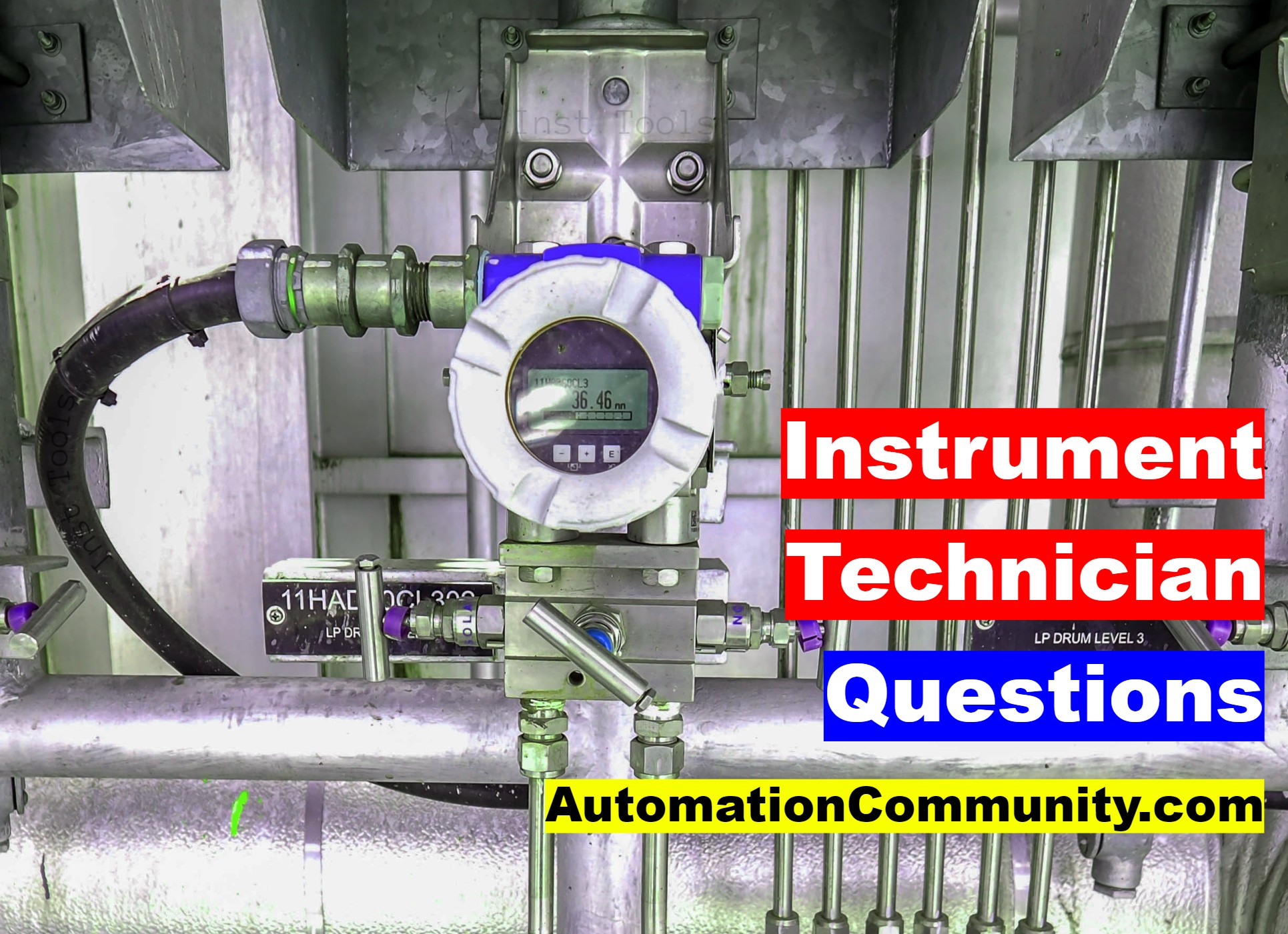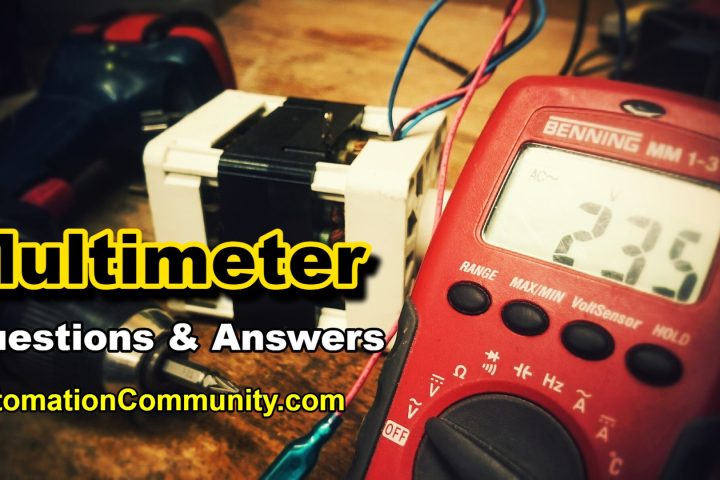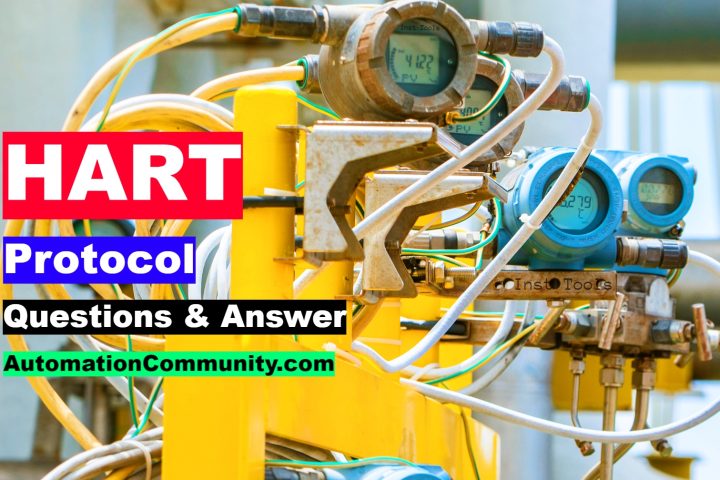Instrument Technician Objective Questions and Answers
We have compiled a list of instrument technician objective questions and answers covering topics such as instrument calibration, practical problems in the field, control systems, and troubleshooting valve issues.
Instrument Technician Objective Questions

These instrumentation questions and answers will help test your knowledge and skills required to excel in this crucial role. Whether you’re a student or a seasoned professional, these resources will be valuable to enhance your understanding of the field and help you succeed in your career.
Which of the following instruments is commonly used to measure temperature?
a) Multimeter
b) Barometer
c) Thermocouple
d) Tachometer
Answer: c) Thermocouple
Explanation: Thermocouples are temperature sensors that measure temperature by the voltage produced when two different metals are joined together.
Which of the following instruments is used to measure pressure?
a) Oscilloscope
b) Voltmeter
c) Manometer
d) Ammeter
Answer: c) Manometer
Explanation: Manometers are instruments used to measure pressure, particularly in fluids like air and water.
Which of the following instruments is used to measure the flow rate of a fluid?
a) Tachometer
b) Flowmeter
c) Voltmeter
d) Multimeter
Answer: b) Flowmeter
Explanation: Flowmeters are instruments used to measure the rate of fluid flow, typically in pipes or channels.
Which of the following instruments is used to measure electrical current?
a) Multimeter
b) Barometer
c) Tachometer
d) Thermocouple
Answer: a) Multimeter
Explanation: A multimeter is an instrument used to measure voltage, current, and resistance in an electrical circuit.
Which of the following instruments is used to measure light intensity?
a) Luminometer
b) Luxmeter
c) Spectrometer
d) Photometer
Answer: b) Luxmeter
Explanation: A luxmeter is an instrument used to measure the intensity of light, typically in units of lux.
Which of the following instruments is used to measure the pH of a solution?
a) Refractometer
b) pH meter
c) Spectrophotometer
d) Colorimeter
Answer: b) pH meter
Explanation: A pH meter is an instrument used to measure the pH of a solution, which indicates its acidity or alkalinity.
Which of the following instruments is used to measure the concentration of a substance in a solution?
a) Chromatograph
b) Spectrophotometer
c) Refractometer
d) Colorimeter
Answer: b) Spectrophotometer
Explanation: A spectrophotometer is an instrument used to measure the amount of light absorbed or transmitted by a sample, which can be used to determine its concentration.
Which of the following instruments is used to measure humidity?
a) Hygrometer
b) Psychrometer
c) Barometer
d) Anemometer
Answer: a) Hygrometer
Explanation: A hygrometer is an instrument used to measure the humidity or moisture content of the air.
Which of the following instruments is used to measure the speed of rotation of a shaft?
a) Tachometer
b) Multimeter
c) Oscilloscope
d) Voltmeter
Answer: a) Tachometer
Explanation: A tachometer is an instrument used to measure the speed of rotation of a shaft, typically in units of revolutions per minute (RPM).
Which of the following instruments is used to measure the level of a liquid in a tank?
a) Altimeter
b) Manometer
c) Level gauge
d) Thermometer
Answer: c) Level gauge
Explanation: A level gauge is an instrument used to measure the level of a liquid in a tank, typically by using a float or a pressure sensor.
Which of the following instruments is used to measure the thickness of a material?
a) Micrometer
b) Caliper
c) Vernier gauge
d) Durometer
Answer: a) Micrometer
Explanation: A micrometer is an instrument used to measure the thickness of a material
Which of the following instruments is used to measure and analyze the frequency of an electrical signal?
a) Ammeter
b) Multimeter
c) Function generator
d) Spectrum analyzer
Answer: d) Spectrum analyzer
Explanation: A spectrum analyzer is an instrument used to measure the frequency spectrum of an electrical signal, which can help identify its components and characteristics.
Which of the following instruments is used to measure the resistance of an electrical component?
a) Voltmeter
b) Ammeter
c) Ohmmeter
d) Wattmeter
Answer: c) Ohmmeter
Explanation: An ohmmeter is an instrument used to measure the resistance of an electrical component, typically in units of ohms.
Which of the following instruments is used to measure the sound level in decibels?
a) Sound level meter
b) Frequency analyzer
c) Audio analyzer
d) Vibration meter
Answer: a) Sound level meter
Explanation: A sound level meter is an instrument used to measure the intensity of sound, typically in units of decibels (dB).
Which of the following instruments is used to measure the strength and direction of a magnetic field?
a) Gaussmeter
b) Fluxmeter
c) Magnetometer
d) Electrometer
Answer: c) Magnetometer
Explanation: A magnetometer is an instrument used to measure the strength and direction of a magnetic field, typically in units of teslas or gauss.
Which of the following is an essential step in calibrating a temperature sensor?
a) Checking the resistance of the sensor
b) Testing the insulation resistance of the sensor
c) Ensuring the sensor is correctly mounted
d) Comparing the sensor output to a known reference
Answer: d) Comparing the sensor output to a known reference
Explanation: Calibrating a temperature sensor involves comparing its output to a known reference temperature, typically using a thermocouple or other calibrated instrument.
Which of the following is a common method for calibrating a pressure gauge?
a) Checking the internal components of the gauge
b) Applying a known pressure to the gauge and comparing the output
c) Measuring the resistance of the gauge coil
d) Testing the insulation resistance of the gauge
Answer: b) Applying a known pressure to the gauge and comparing the output
Explanation: Calibrating a pressure gauge involves applying a known pressure to the gauge and comparing its output to a calibrated reference, typically using a deadweight tester or other calibrated instrument.
Which of the following is an important factor to consider when calibrating a flowmeter?
a) The viscosity of the fluid being measured
b) The temperature of the fluid being measured
c) The pressure of the fluid being measured
d) All of the above
Answer: d) All of the above
Explanation: When calibrating a flowmeter, it is essential to consider factors such as the viscosity, temperature, and pressure of the fluid being measured, as these can affect the accuracy of the measurement.
Which of the following is an important factor to consider when calibrating an electrical meter?
a) The type of electrical signal being measured
b) The frequency of the electrical signal being measured
c) The voltage and current ranges of the meter
d) All of the above
Answer: d) All of the above
Explanation: When calibrating an electrical meter, it is essential to consider factors such as the type of signal being measured (AC or DC), the frequency of the signal, and the voltage and current ranges of the meter.
Which of the following is an important step in calibrating a torque wrench?
a) Checking the internal components of the wrench
b) Applying a known torque to the wrench and comparing the output
c) Measuring the resistance of the wrench coil
d) Testing the insulation resistance of the wrench
Answer: b) Applying a known torque to the wrench and comparing the output
Explanation: Calibrating a torque wrench involves applying a known torque to the wrench and comparing its output to a calibrated reference, typically using a torque calibration system or other calibrated instrument.
What could be the reason for a pressure transmitter to read zero even though the process is operational?
a) The pressure transmitter sensor failed
b) The transmitter’s zero point is out of adjustment
c) The transmitter’s span point is out of adjustment
d) The transmitter’s wiring is damaged or loose
Answer: b) The transmitter’s zero point is out of adjustment
Explanation: If the pressure transmitter reads zero even though the process is operational, the likely cause is that the transmitter’s zero point is out of adjustment. This can be corrected by re-calibrating the transmitter.
How can you troubleshoot an electrical instrument that is not receiving power?
a) Check the wiring and connections
b) Test the power source with a multimeter
c) Check the fuse or circuit breaker
d) All of the above
Answer: d) All of the above
Explanation: If an electrical instrument is not receiving power, the problem may be related to the wiring and connections, the power source, or a blown fuse or tripped circuit breaker. To troubleshoot the issue, you should check all of these components.
What could be the cause of erratic readings on a temperature indicator?
a) The sensor is shorted
b) The indicator fuse is blown out
c) The sensor or indicator is damaged or dirty
d) The temperature being measured is constant
Answer: c) The sensor or indicator is damaged or dirty
Explanation: If a temperature indicator is displaying erratic readings, the likely cause is that the sensor or indicator is damaged or dirty. Cleaning or replacing the components may help resolve the issue.
What is the purpose of a control valve in a process control system?
a) To regulate the flow of a process fluid
b) To regulate the pressure of a process fluid
c) To regulate the temperature of a process fluid
d) To control the level of a process fluid
Answer: a) To regulate the flow of a process fluid
Explanation: A control valve is used to regulate the flow of a process fluid in a process control system. By adjusting the valve’s position, the flow rate can be increased or decreased as needed to maintain the desired process conditions.
What is the purpose of a PLC in a process control system?
a) Only control the operation of motors and drives
b) Only monitor process variables such as temperature and pressure
c) To monitor & control the sequence of operations in a process
d) To provide process performance
Answer: c) To monitor & control the sequence of operations in a process
Explanation: A programmable logic controller (PLC) is used in process control systems to monitor and control the sequence of operations in a process. By receiving input signals from sensors and other devices, the PLC can control the operation of pumps, motors, valves, and other process equipment.
What is the purpose of a PID controller in a process control system?
a) To provide real-time data on process performance
b) To monitor process variables such as temperature and pressure
c) To monitor the operation of motors and drives
d) To regulate the process variable to a setpoint
Answer: d) To regulate the process variable to a setpoint
Explanation: A proportional-integral-derivative (PID) controller is used in process control systems to regulate the process variable to a setpoint. By continuously adjusting the control signal based on the difference between the setpoint and the measured process variable, the PID controller can maintain the desired process conditions.
What are some common problems that can occur with valves in a process control system?
a) Leaking
b) Sticking
c) Overheating
d) All of the above
Answer: d) All of the above
Explanation: Valves in a process control system can experience a variety of problems, including leaking, sticking, and overheating. These problems can cause inaccurate process control, reduced efficiency, and equipment damage if not addressed promptly.
How can an instrument technician troubleshoot a valve problem in a process control system?
a) Inspect the valve and surrounding piping for leaks
b) Check the valve’s position and movement
c) Monitor the process variable to determine if the valve is regulating flow properly
d) All of the above
Answer: d) All of the above
Explanation: To troubleshoot a valve problem in a process control system, an instrument technician can inspect the valve and surrounding piping for leaks, check the valve’s position and movement, and monitor the process variable to determine if the valve is regulating flow properly. By identifying the root cause of the problem, the technician can take corrective action to restore proper valve function.
How can an instrument technician determine if a valve positioner is functioning properly?
a) Check the valve’s position and movement
b) Monitor the process variable to determine if the valve is regulating flow properly
c) Inspect the positioner for physical damage or wear
d) All of the above
Answer: d) All of the above
Explanation: To determine if a valve positioner is functioning properly, an instrument technician can check the valve’s position and movement, monitor the process variable to determine if the valve is regulating flow properly, and inspect the positioner for physical damage or wear. By identifying any issues with the positioner, the technician can take corrective action to restore proper valve function.
What is a transmitter in a process control system?
a) A device used to transmit data from one location to another
b) A device used to regulate the flow of a process fluid
c) A device used to measure and transmit process variables such as temperature, pressure, and flow rate
d) A device used to power other instruments in the system
Answer: c) A device used to measure and transmit process variables such as temperature, pressure, and flow rate
Explanation: A transmitter is a device used to measure process variables such as temperature, pressure, and flow rate and transmit this information to the process control system for monitoring and control.
What is the function of a pressure transmitter?
a) To measure and transmit pressure readings from a process line
b) To regulate the pressure of a process fluid
c) To control the flow of a process fluid
d) To monitor the temperature of a process fluid
Answer: a) To measure and transmit pressure readings from a process line
Explanation: A pressure transmitter is used to measure the pressure of a process fluid and transmit this information to the process control system for monitoring and control.
What is the purpose of a temperature transmitter?
a) To measure and transmit temperature readings from a process line
b) To regulate the temperature of a process fluid
c) To control the flow of a process fluid
d) To monitor the pressure of a process fluid
Answer: a) To measure and transmit temperature readings from a process line
Explanation: A temperature transmitter is used to measure the temperature of a process fluid and transmit this information to the process control system for monitoring and control.
How can an instrument technician calibrate a transmitter in a process control system?
a) Adjust the zero and span settings to match a known reference value
b) Check the transmitter’s electrical connections for loose or corroded wires
c) Inspect the transmitter for physical damage or wear
d) All of the above
Answer: a) Adjust the zero and span settings to match a known reference value
Explanation: To calibrate a transmitter in a process control system, an instrument technician can adjust the zero and span settings to match a known reference value. This ensures accurate measurement and transmission of process variables.
What is a differential pressure transmitter used for in a process control system?
a) To measure the pressure difference between two points in a process line
b) To regulate the flow rate of a process fluid
c) To monitor the temperature of a process fluid
d) To control the level of a process fluid in a tank or vessel
Answer: a) To measure the pressure difference between two points in a process line
Explanation: A differential pressure transmitter is used to measure the pressure difference between two points in a process line, which can be used to calculate variables such as flow rate or level in the process.
How does a pressure transmitter work in a process control system?
a) It measures the pressure of a process fluid and converts it into an electrical signal that can be transmitted to the control system.
b) It regulates the pressure of a process fluid by adjusting a control valve in the system.
c) It monitors the pressure of a process fluid and sends an alarm signal to the control system if it goes out of range.
d) It controls the flow rate of a process fluid by adjusting a flow control valve in the system.
Answer: a) It measures the pressure of a process fluid and converts it into an electrical signal that can be transmitted to the control system.
Explanation: A pressure transmitter measures the pressure of process fluid and converts it into an electrical signal that can be transmitted to the process control system for monitoring and control.
Read Next:














